
The Solar-Terrestrial Centre of Excellence (STCE) is a collaborative network of the Belgian Institute for Space Aeronomy, the Royal Observatory of Belgium and the Royal Meteorological Institute of Belgium.
 |
Published by the STCE - this issue : 10 Oct 2014. The Solar-Terrestrial Centre of Excellence (STCE) is a collaborative network of the Belgian Institute for Space Aeronomy, the Royal Observatory of Belgium and the Royal Meteorological Institute of Belgium. |
| Archive of the newsletters | Subscribe to this newsletter by mail |
Last week's highlight certainly was the M7.3 flare that was produced by the sunspot complex NOAA 2172/2173. This flare peaked on 2 October at 19:01UT, and was preceded by a long duration M1.5 flare peaking at 17:44UT in the same area near the southwest solar limb.

The flare, and especially its intensity, came rather as a surprise. Though the area had produced various M-class flares during the previous weekend, it had quieted down over the next few days. In fact, no flare was recorded for 36 hours prior to the 2 October events. The two sunspot groups had also reduced in sunspot area and magnetic complexity, though the proximity near the solar limb made an accurate assessment of the latter more difficult.
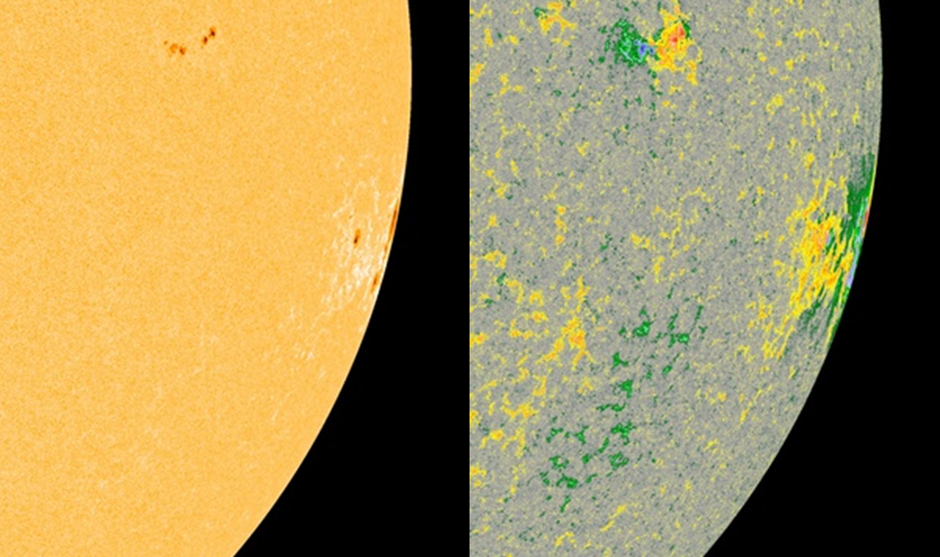
This movie at http://youtu.be/TVbjMozbtco shows the evolution in white light and the magnetogram of the Sun from 27 September till 2 October. It is followed by the outlook of the flares as seen in H-alpha (lower chromosphere) and in AIA304 (transition zone). Then comes a zoom in the combined light from the AIA 304 and 131 filters showing also the hotter areas of the flare (blue). The final clip shows the associated coronal mass ejection, which was directed to the southwest (lower right) and away from Earth.
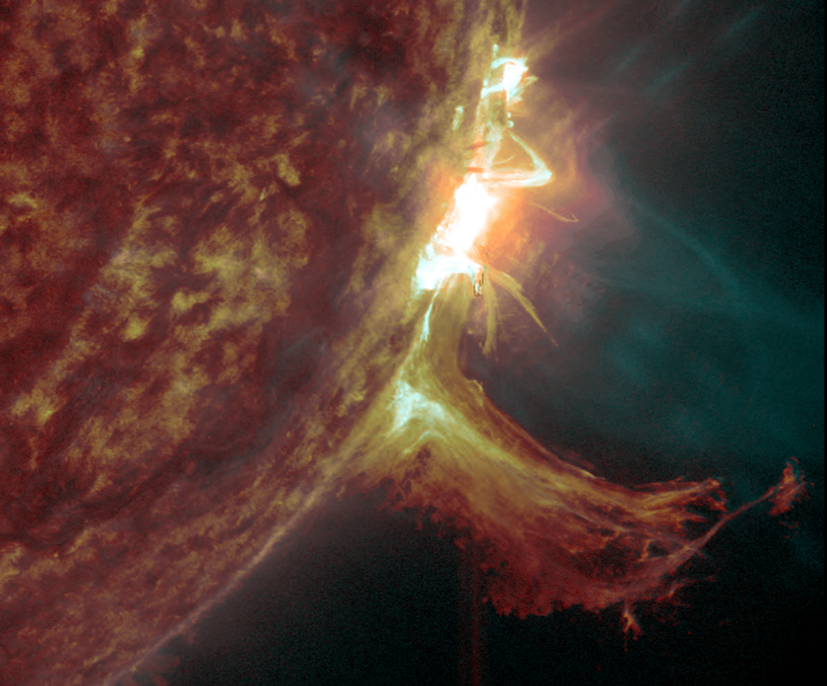
Credits: Data and imagery were taken from SDO (http://sdo.gsfc.nasa.gov/data/aiahmi/), SOHO (http://sohowww.nascom.nasa.gov/home.html), GONG H-alpha Network (http://halpha.nso.edu/), STAFF (http://sun-ts-dev.oma.be/), and Helioviewer (http://helioviewer.org/).
Attention - Attention
This year, the Belgian Institute for Space Aeronomy (BISA) celebrates its 50th anniversary. On that occasion, an Open Door will be organized at the Space Pole during the weekend of 11 and 12 October. The STCE participates extensively with numerous activities.
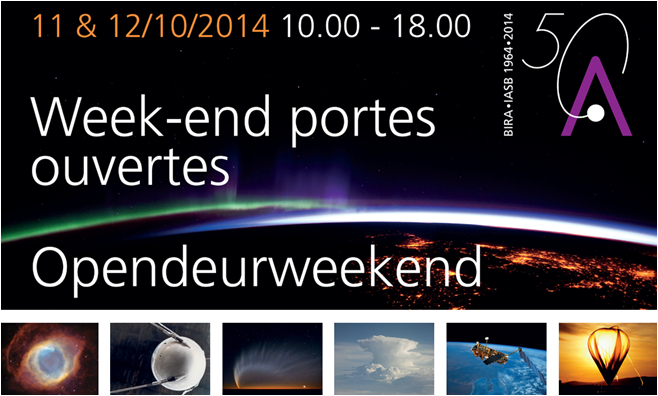
50 years BIRA-IASB:
http://50.aeronomie.be/index.php
STCE activities
http://www.stce.be/news/270/welcome.html
Solar flare activity fluctuated between low and moderate during the week.
In order to view the activity of this week in more detail, we suggest to go to the following website from which all the daily (normal and difference) movies can be accessed: http://proba2.oma.be/ssa
This page also lists the recorded flaring events.
A weekly overview movie can be found here (SWAP week 236).
http://proba2.oma.be/swap/data/mpg/movies/WeeklyReportMovies/WR236_Sep29_Oct05/weekly_movie_2014_09_29.mp4
Details about some of this week's events, can be found further below.
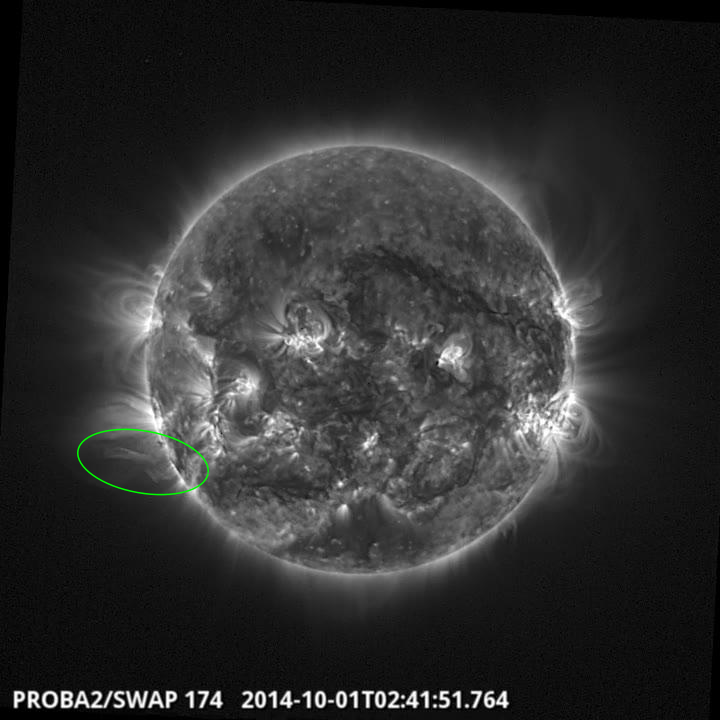
Failed eruption on the east Limb @ 02:41 SWAP image
Find a movie of the event here (SWAP movie)
http://proba2.oma.be/swap/data/mpg/movies/20141001_swap_movie.mp4
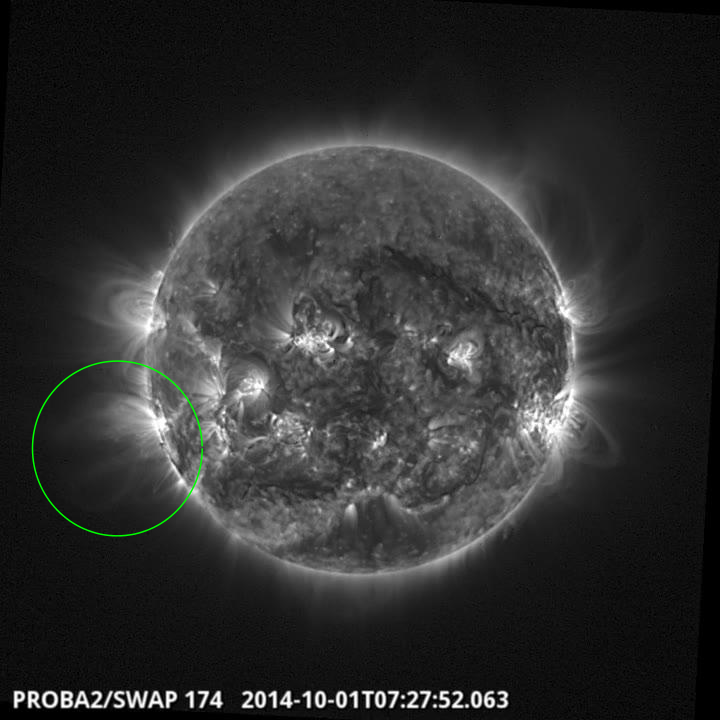
Eruption on the east limb @ 07:27 SWAP image
Find a movie of the event here (SWAP movie)
http://proba2.oma.be/swap/data/mpg/movies/20141001_swap_movie.mp4
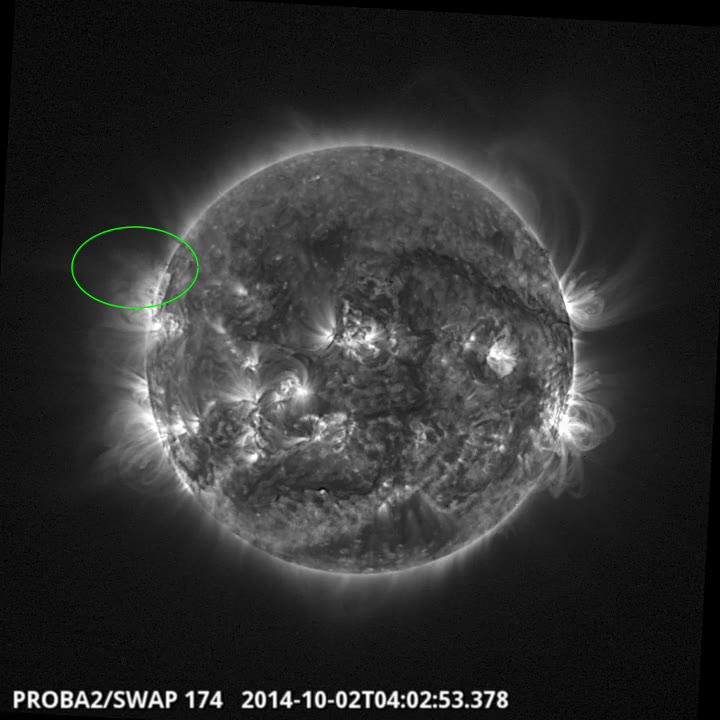
Eruption on the east limb @ 04:02 SWAP image
Find a movie of the event here (SWAP movie)
http://proba2.oma.be/swap/data/mpg/movies/20141002_swap_movie.mp4
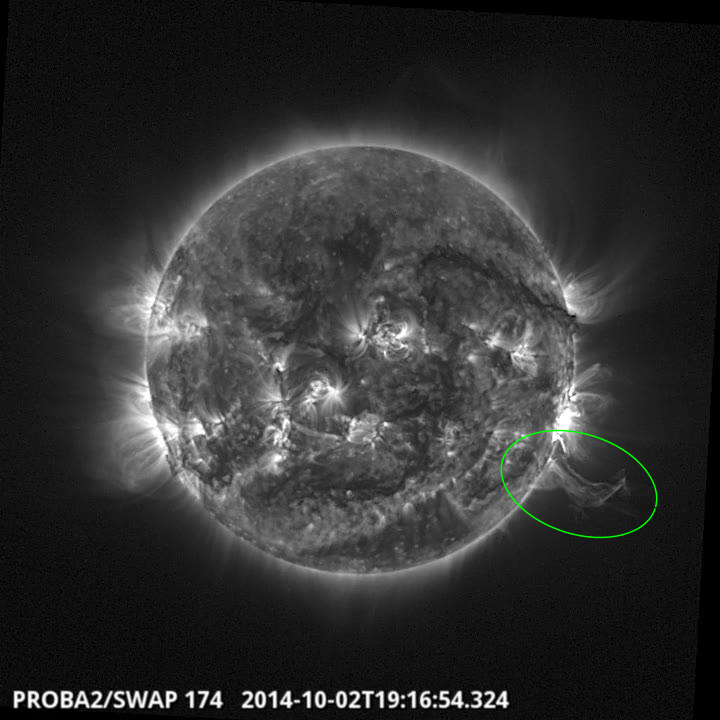
Eruption on the west limb @ 19:16 SWAP image
Find a movie of the event here (SWAP movie)
http://proba2.oma.be/swap/data/mpg/movies/20141002_swap_movie.mp4
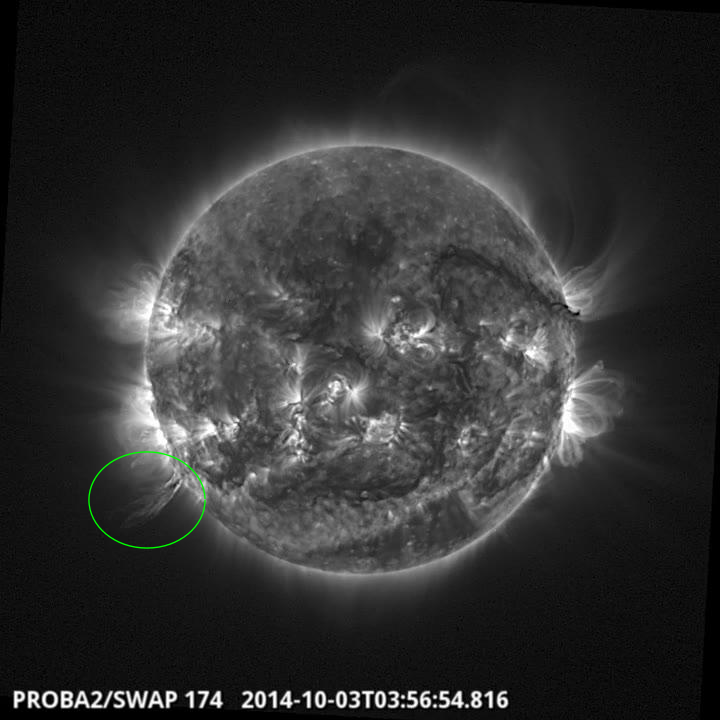
Eruption on the west limb @ 03:56 SWAP image
Find a movie of the event here (SWAP movie)
http://proba2.oma.be/swap/data/mpg/movies/20141003_swap_movie.mp4
A total of 25 C- and 2 M-class flares were recorded last week. The sunspot complex NOAA 2172/2173 produced about half of these C-class flares (14) as well as the two M-class events. These groups gradually declined in sunspot area and simplified their magnetic configuration, but still produced a long-duration M1.5 flare and a M7.3 flare on 2 October (peaking resp. at 17:44UT and 19:01UT) while rounding the southwest solar limb. The associated CME was directed to the southwest and away from Earth. The other 11 C-class flares had 5 different source regions and were mostly low-level. Compact region NOAA 2175 developed a prominent delta structure but did not produce a single flare last week.
Two 20-degrees long filaments transited the western solar hemisphere but remained quiet and did not erupt. A two-step filament eruption took place between 03:00 and 06:00UT on 2 October near the central meridian (20-30 degrees North), but was not associated to a CME. Most of the CME activity took place at or just behind the east limb, with prominent CMEs observed on 29 September (first seen by LASCO on 05:00UT), and on 1, 2 and 3 October (resp. at 08:12UT, 04:24UT and 13:48UT). None of these CMEs had an Earth-directed component.
The x-ray background flux was above the C1-level until late on 3 October. The greater than 10 MeV proton flux was at nominal levels whole week.
During the first four days of the period, solar wind was at nominal conditions with wind speed mostly between 340 and 400 km/s and Bz fluctuating between -7 and +5 nT. Geomagnetic conditions were mostly quiet to unsettled, with some isolated active episodes recorded both locally as in Kp.
Starting late on 3 October, a corotating interaction region influenced the solar wind. Solar wind speed gradually increased from an average 350 km/s to peak values around 480 km/s early on 5 October. Around 17:00UT on 4 October, the direction of the IMF turned towards the Sun. Bz was mostly positive up to +10 nT before this change, and fluctuating between -5 and +10 nT after this change in IMF direction. Geomagnetic conditions remained quiet to unsettled.
| DAY | BEGIN | MAX | END | LOC | XRAY | OP | 10CM | TYPE | Cat | NOAA |
| 02 | 1710 | 1744 | 1815 | S18W76 | M1.5 | SF | 60 | 2172 | ||
| 02 | 1849 | 1901 | 1914 | S17W82 | M7.3 | 1F | II/1IV/1 | 59 | 2173 |
| LOC: approximate heliographic location | TYPE: radio burst type |
| XRAY: X-ray flare class | Cat: Catania sunspot group number |
| OP: optical flare class | NOAA: NOAA active region number |
| 10CM: peak 10 cm radio flux |

The figure shows the time evolution of the Vertical Total Electron Content (VTEC) (in red) during the last week at three locations:
a) in the northern part of Europe(N61°, 5°E)
b) above Brussels(N50.5°, 4.5°E)
c) in the southern part of Europe(N36°, 5°E)
This figure also shows (in grey) the normal ionospheric behaviour expected based on the median VTEC from the 15 previous days.
The VTEC is expressed in TECu (with TECu=10^16 electrons per square meter) and is directly related to the signal propagation delay due to the ionosphere (in figure: delay on GPS L1 frequency).
The Sun's radiation ionizes the Earth's upper atmosphere, the ionosphere, located from about 60km to 1000km above the Earth's surface.The ionization process in the ionosphere produces ions and free electrons. These electrons perturb the propagation of the GNSS (Global Navigation Satellite System) signals by inducing a so-called ionospheric delay.
See http://stce.be/newsletter/GNSS_final.pdf for some more explanations ; for detailed information, see http://gnss.be/ionosphere_tutorial.php
Start : 2014-11-12
This conference aims to bring together researchers, engineers,
users in the area of Big Data in the Space sector.
The focus is on the whole data lifecycle, ranging from data
acquisition by spaceborne and ground-based sensors to data
management, analysis and exploitation in the domains of Earth
Observation, Space Science, Space Engineering, Space Weather,
etc.
Special emphasis will be put on highlighting synergies and
cross-fertilization opportunities from domains like Climate Change,
Solid Earth Science, Planetary Sciences, Life Science,
Astrophysics, High Energy Physics, Social Sciences, etc.
We expect this conference to:
* contribute towards a common "Big Data from Space" scientific
and programmatic framework
* widen competences and expertise of universities, labs and
industrial actors
* foster networking of experts and users towards better access
and sharing of data, tools and resources
* leverage innovation, spin-in, spin off of technologies, and
business development arising from research and industry
progress
Website:
http://congrexprojects.com/2014-events/BigDatafromSpace/objectives
Start : 2014-11-17 - End : 2014-11-21
The 11th Edition of the European Space Weather Week will take
place on 17-21nd November 2014 in Liège, Belgium.
The ESWW will again adopt the central aim of bringing together
the diverse groups in Europe working on different aspects of Space
Weather. This includes but isn't limited to the scientific
community, the engineering community, applications developers,
service providers and service end users.
The meeting organisation is coordinated by the Belgian
Solar-Terrestrial Centre of Excellence (STCE), ESA and the Space
Weather Working Team. The local organisation is done by the
STCE.
Website:
http://www.stce.be/esww11/
Start : 2014-12-15 - End : 2014-12-19
The AGU Fall Meeting is the largest worldwide conference in the
geophysical sciences, attracting more than 22,000 Earth and space
scientists, educators, students, and other leaders. For 46 years,
energized and passionate Earth and space scientists from around the
world gather at the AGU Fall Meeting to connect with colleagues,
broaden their knowledge base, and embrace the joy of science. The
2014 meeting takes place Monday 15 - Friday 19 December 2014.
Several sessions about space weather are foreseen:
*
When and Why Does Space weather Forecasting Fail?
*
Addressing Operational Space Weather Needs
*
Near Real Time Data for Earth Science and Space Weather
Applications
*
Understanding Hemispheric Asymmetry and Space Weather
*
Connection of Solar Events With the Variability of Space
Environments
*
Bz from the Sun to the Earth: Observations and Modeling
*
Solar Sources and Heliospheric Consequences of Coronal Mass
Ejections in Solar Cycle 24
*
Advances in Ionospheric Forecasting - Modeling, Observations, and
Validation
Abstract Submission Deadline: August 6, 2014
Website:
http://fallmeeting.agu.org/2014/
Start : 2015-04-20 - End : 2015-04-24
This gathering was born out of the desire to collect in one
place the latest technologies required for advancement of science
in the discipline of Solar and Space Physics. In doing so, it was
recognized that the two 1998 volumes of 'Measurement Techniques in
Space Plasmas' (Particles and Fields) have been a valuable
reference and resource for advanced students and scientists who
wish to know the fundamentals of measurement techniques and
technology.
Website:
https://mtssp.msfc.nasa.gov/
Start : 2015-06-22 - End : 2015-07-02
We invite contributions on novel inversion methods with
application across the geosciences. Of particular interest are 3D
imaging, joint inversion of geodetic, geophysical and geochemical
datasets, and multi-disciplinary interpretation approaches such as
integration of gravity, EM and seismic data or thermo-mechanical
modelling studies constrained by physical parameters.
Modelling of Space Weather Effects: Solar, Magnetospheric and
Earth Resistivity Constraints (IAGA, IAMAS)
In this symposium we welcome contributions on all aspects of the
modelling of space weather and its effects, from the Sun to Earth.
This includes the modelling of the various interactions between
travelling solar storms and the solar wind, magnetosphere,
ionosphere and solid Earth and the validation of models through
measurements. Contributions on models developed to aid end-users,
such as satellite and power grid operators, survive the impact of
space weather are also encouraged.
Website:
http://www.iugg2015prague.com/joint-inter-association-symposia.htm#JA